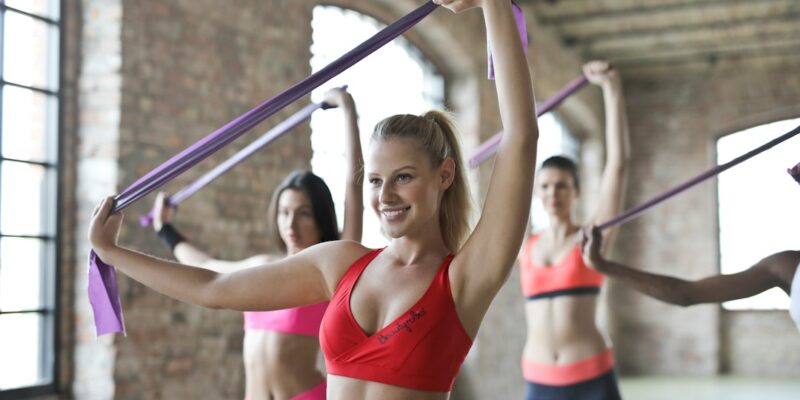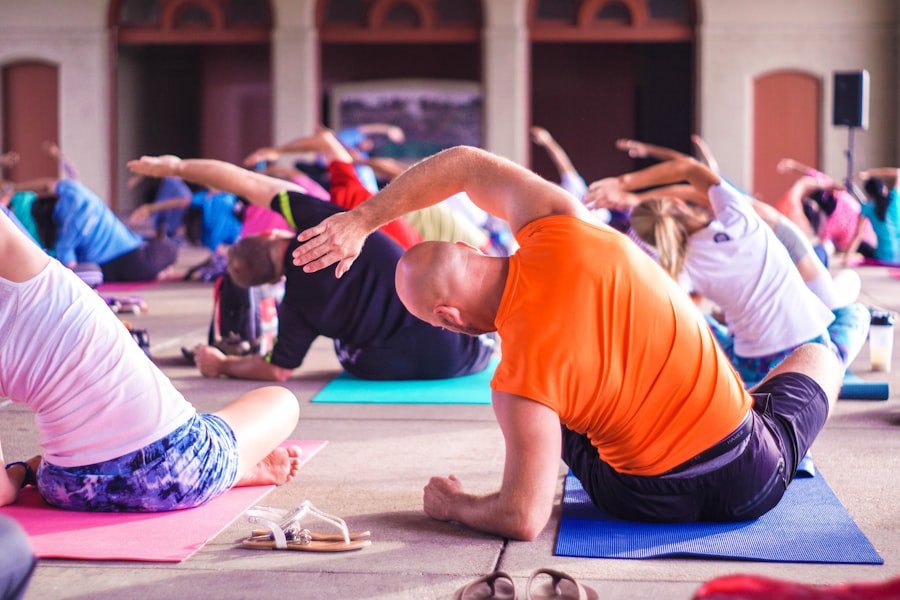
Boost Your Fitness Routine: How to Incorporate Dumbbell Exercises for Maximum Results
Dumbbell exercises have become increasingly popular in recent years due to their numerous benefits. Whether you prefer to work out at home or in the gym, dumbbell exercises offer a versatile and effective way to strengthen and tone your muscles. One of the main advantages of dumbbell exercises is that they allow for a wide range of motion, which helps to engage multiple muscle groups at once. This can lead to more efficient workouts and better overall results.
In addition to their versatility, dumbbell exercises also offer the convenience of being able to be done at home. Many people find it difficult to make it to the gym on a regular basis, but with a set of dumbbells, you can easily create a challenging workout routine in the comfort of your own home. This makes it easier to stay consistent with your workouts and achieve your fitness goals.
Key Takeaways
- Dumbbell exercises offer numerous benefits for overall fitness and strength training.
- Proper warm-up exercises are essential before starting any dumbbell workout.
- Upper body dumbbell exercises can help strengthen arms, shoulders, and chest muscles.
- Lower body dumbbell exercises can help tone legs and glutes for a more defined physique.
- Core dumbbell exercises can help strengthen the midsection and improve overall stability.
Warm-Up Exercises to Prepare for Dumbbell Workouts
Before diving into your dumbbell workout, it is important to properly warm up your body. Warming up helps to increase blood flow to your muscles, improve flexibility, and reduce the risk of injury. There are several warm-up exercises that can be done before starting your dumbbell workout.
One effective warm-up exercise is jumping jacks. This exercise helps to increase your heart rate and warm up your entire body. Start by standing with your feet together and your arms by your sides. Jump up, spreading your legs out wide and raising your arms above your head. Jump again, returning to the starting position. Repeat this motion for 1-2 minutes.
Another great warm-up exercise is lunges. Lunges help to stretch and activate the muscles in your legs and hips. Start by standing with your feet hip-width apart. Take a big step forward with your right foot, bending both knees until your right thigh is parallel to the ground and your left knee is hovering just above the floor. Push through your right heel to return to the starting position. Repeat on the other side. Do 10-12 lunges on each leg.
Upper Body Dumbbell Exercises for Strengthening Arms, Shoulders, and Chest
Dumbbell exercises are excellent for targeting the muscles in your upper body, including your arms, shoulders, and chest. One popular exercise is the bicep curl. Stand with your feet hip-width apart and hold a dumbbell in each hand, palms facing forward. Keeping your elbows close to your sides, curl the dumbbells up towards your shoulders. Slowly lower them back down to the starting position. Repeat for 10-12 reps.
Another effective upper body exercise is the shoulder press. Start by standing with your feet hip-width apart and hold a dumbbell in each hand at shoulder level, palms facing forward. Press the dumbbells up overhead until your arms are fully extended. Slowly lower them back down to the starting position. Repeat for 10-12 reps.
To target your chest muscles, try chest flys. Lie on a bench or the floor with a dumbbell in each hand, palms facing each other. Extend your arms out to the sides, keeping a slight bend in your elbows. Slowly bring the dumbbells together in front of your chest, squeezing your chest muscles as you do so. Return to the starting position and repeat for 10-12 reps.
Lower Body Dumbbell Exercises for Toning Legs and Glutes
| Exercise | Muscles Worked | Repetitions | Sets | Weight |
|---|---|---|---|---|
| Squats | Quadriceps, Hamstrings, Glutes | 10-12 | 3-4 | 10-20 lbs |
| Lunges | Quadriceps, Hamstrings, Glutes | 10-12 (each leg) | 3-4 | 10-20 lbs |
| Deadlifts | Hamstrings, Glutes, Lower Back | 8-10 | 3-4 | 20-30 lbs |
| Step-ups | Quadriceps, Hamstrings, Glutes | 10-12 (each leg) | 3-4 | 10-20 lbs |
| Glute Bridges | Glutes, Hamstrings | 12-15 | 3-4 | 10-20 lbs |
Dumbbell exercises are not just limited to the upper body – they can also be used to target and tone the muscles in your lower body. One of the most effective lower body exercises is the squat. Stand with your feet shoulder-width apart and hold a dumbbell in each hand at your sides. Bend at the knees and hips, lowering yourself down into a squat position. Keep your chest up and your weight in your heels. Push through your heels to return to the starting position. Repeat for 10-12 reps.
Another great lower body exercise is the lunge. Stand with your feet hip-width apart and hold a dumbbell in each hand at your sides. Take a big step forward with your right foot, bending both knees until your right thigh is parallel to the ground and your left knee is hovering just above the floor. Push through your right heel to return to the starting position. Repeat on the other side. Do 10-12 lunges on each leg.
For targeting the muscles in your glutes and hamstrings, try deadlifts. Stand with your feet hip-width apart and hold a dumbbell in each hand in front of your thighs, palms facing your body. Hinge at the hips, keeping your back straight, and lower the dumbbells towards the ground. Keep a slight bend in your knees as you lower the dumbbells as far as you can while maintaining proper form. Engage your glutes and hamstrings to return to the starting position. Repeat for 10-12 reps.
Core Dumbbell Exercises for a Stronger Midsection
Dumbbell exercises can also be used to strengthen and tone your core muscles. One effective exercise is Russian twists. Sit on the floor with your knees bent and feet flat on the ground. Hold a dumbbell with both hands in front of your chest. Lean back slightly, engaging your core muscles. Twist your torso to the right, bringing the dumbbell towards the ground next to your hip. Twist back to center and then twist to the left, bringing the dumbbell towards the ground next to your left hip. Repeat for 10-12 reps on each side.
Weighted sit-ups are another great core exercise using dumbbells. Lie on your back with your knees bent and feet flat on the ground. Hold a dumbbell against your chest. Engage your core muscles and slowly lift your upper body off the ground, curling towards your knees. Slowly lower back down to the starting position. Repeat for 10-12 reps.
Full-Body Dumbbell Workouts for Maximum Results

If you’re looking to get the most out of your dumbbell workouts, incorporating full-body exercises is key. Full-body workouts engage multiple muscle groups at once, leading to more efficient and effective workouts. Here are a few examples of full-body dumbbell workouts:
1. Squat to Overhead Press: Start with a dumbbell in each hand at shoulder level. Perform a squat, lowering yourself down until your thighs are parallel to the ground. As you stand back up, press the dumbbells overhead. Repeat for 10-12 reps.
2. Renegade Rows: Start in a high plank position with a dumbbell in each hand, wrists directly under your shoulders. Row one dumbbell up towards your chest, keeping your elbow close to your body. Lower it back down and repeat on the other side. Alternate rows for 10-12 reps on each side.
3. Dumbbell Burpees: Hold a dumbbell in each hand at your sides. Squat down and place the dumbbells on the ground in front of you. Jump or step back into a plank position, then jump or step back up to standing. Pick up the dumbbells and repeat for 10-12 reps.
How to Choose the Right Dumbbells for Your Fitness Level
Choosing the right dumbbells for your fitness level is crucial to ensure that you are challenging yourself without risking injury. It is important to start with a weight that allows you to perform each exercise with proper form and technique.
If you are new to strength training, start with a lighter weight, such as 5-10 pounds. As you become more comfortable and your strength increases, gradually increase the weight. It is better to start with a lighter weight and focus on proper form than to use a heavier weight and sacrifice form.
When choosing dumbbells, consider your current fitness level and the exercises you plan to do. If you are just starting out, a set of adjustable dumbbells may be a good option as they allow you to easily increase or decrease the weight as needed. If you are more advanced, you may want to invest in a set of fixed-weight dumbbells.
Tips for Proper Form and Technique to Avoid Injury
Proper form and technique are essential when performing dumbbell exercises to avoid injury and get the most out of your workouts. Here are some tips to help you maintain proper form:
– Keep your core engaged: Engaging your core muscles helps to stabilize your body and protect your lower back.
– Maintain proper alignment: Keep your spine neutral and avoid rounding or arching your back.
– Use a full range of motion: Perform each exercise through its full range of motion to engage the targeted muscles fully.
– Control the weight: Avoid using momentum to lift the weights. Instead, focus on controlled movements.
– Breathe properly: Exhale during the exertion phase of the exercise and inhale during the relaxation phase.
It is also important to listen to your body and stop if you feel any pain or discomfort. If you are unsure about proper form or technique, consider working with a certified personal trainer who can guide you through the exercises and ensure that you are performing them correctly.
How to Incorporate Dumbbell Exercises into Your Existing Fitness Routine
If you already have an existing fitness routine, incorporating dumbbell exercises can help add variety and target different muscle groups. Here are some tips for adding dumbbell exercises to your routine:
– Start with a warm-up: Begin your workout with a dynamic warm-up to prepare your body for the exercises.
– Choose a variety of exercises: Select dumbbell exercises that target different muscle groups to ensure a balanced workout.
– Alternate upper and lower body exercises: Alternate between upper and lower body exercises to give each muscle group time to recover.
– Include core exercises: Incorporate core exercises into your routine to strengthen your midsection and improve stability.
– Gradually increase weight and intensity: As you become stronger, gradually increase the weight and intensity of your dumbbell exercises.
It is important to create a balanced workout that targets all muscle groups and allows for proper recovery. If you are unsure how to incorporate dumbbell exercises into your existing routine, consider consulting with a personal trainer who can help you create a customized plan.
The Importance of Variety in Your Fitness Regimen
In conclusion, dumbbell exercises offer numerous benefits and can be easily incorporated into your fitness routine. Whether you choose to work out at home or in the gym, dumbbell exercises provide a versatile and effective way to strengthen and tone your muscles.
By incorporating upper body, lower body, and core exercises into your routine, you can target all major muscle groups for maximum results. It is important to choose the appropriate weight for your fitness level and focus on proper form and technique to avoid injury.
Adding dumbbell exercises to your existing fitness routine can help add variety and prevent boredom. By continuously challenging yourself and incorporating different exercises, you can prevent plateauing and continue to see progress in your fitness journey. So grab a set of dumbbells and start reaping the benefits of these versatile and effective exercises today!
FAQs
What are dumbbell exercises?
Dumbbell exercises are strength training exercises that involve the use of dumbbells, which are handheld weights that come in various sizes and weights.
What are the benefits of incorporating dumbbell exercises into your workouts?
Incorporating dumbbell exercises into your workouts can help increase muscle strength, improve muscle tone, enhance overall fitness, and promote weight loss.
What are some examples of dumbbell exercises?
Some examples of dumbbell exercises include bicep curls, tricep extensions, shoulder presses, chest presses, lunges, squats, and deadlifts.
How do I choose the right weight for my dumbbell exercises?
The right weight for your dumbbell exercises will depend on your fitness level and the specific exercise you are performing. It is recommended to start with a lighter weight and gradually increase as you become stronger.
How often should I incorporate dumbbell exercises into my workouts?
It is recommended to incorporate dumbbell exercises into your workouts at least two to three times per week for optimal results.
Can dumbbell exercises be done at home?
Yes, dumbbell exercises can be done at home with a set of dumbbells and a workout mat. It is important to ensure proper form and technique to avoid injury.


















